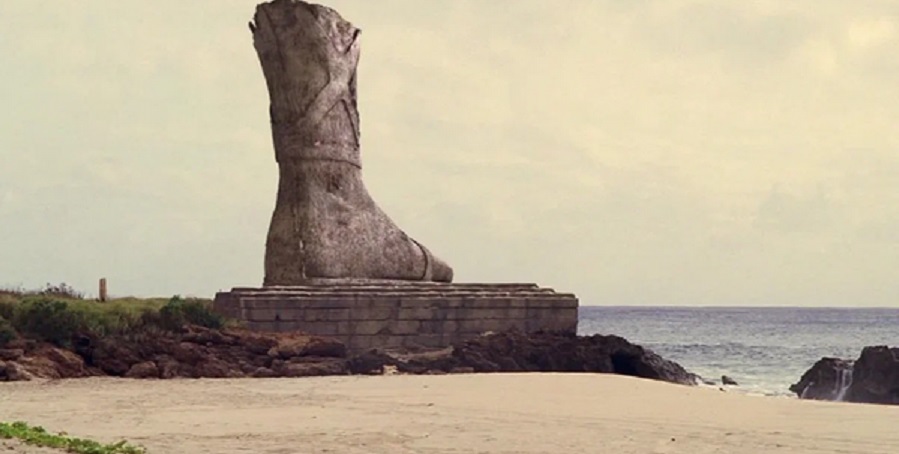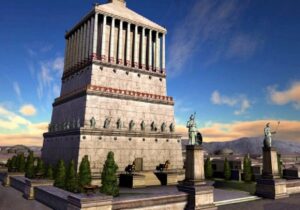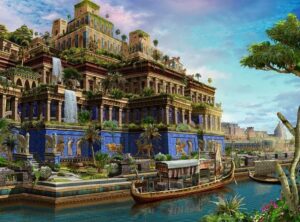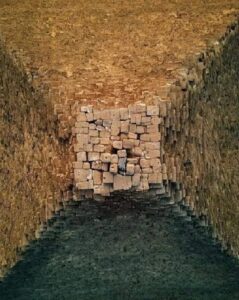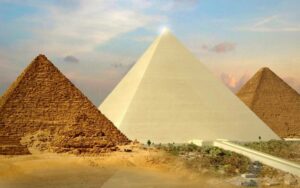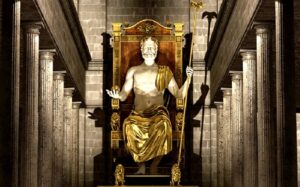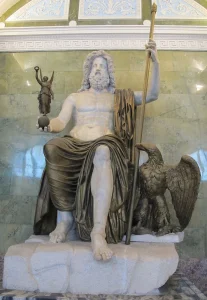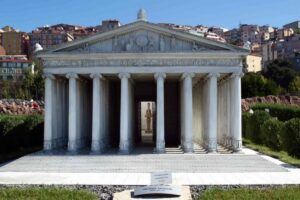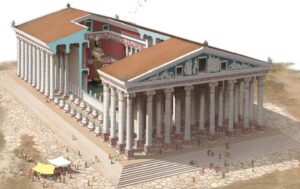The ancient “Seven Wonders of the World” once amazed contemporaries. These were large-scale projects that were meant to withstand millennia.
Unfortunately, only the Great Pyramid of Giza from this list has survived to this day. In this article, we will describe what happened to the other wonders of the world and what remains of them today.
Colossus of Rhodes
The Colossus of Rhodes was a colossal statue of the sun god Helios that stood in the ancient Greek city of Rhodes.
The story of its construction is as follows. In the third century BC, Rhodes was under siege – another king of Macedonia, Demetrius, came to conquer it (the fame of the famous Alexander the Great gave them no rest! But they couldn’t repeat his success).
 This is what the statue might have looked like today, according to the artists from NeoMam Studios.
This is what the statue might have looked like today, according to the artists from NeoMam Studios.
Rhodes withstood the siege, and the Macedonians were repelled. They took their siege weapons, sold them, and came out ahead. The extra money was spent on the construction of a powerful monument in memory of their glorious victory!
They spent 13 tons of bronze and about 8 tons of iron – by the standards of that time, these were gigantic resources!
For 12 years, the sculptor Chares created his masterpiece. And, finally, the new Wonder of the World was ready!
The Colossus stood for only half a century before it was toppled by an earthquake.
And so, the Colossus remained lying down for 800 years. It was broken at the knee level.
 A frame from the TV series Lost.
A frame from the TV series Lost.
In the 7th century AD, Rhodes was captured by the Arabs. Caliph Muawiyah I melted down the statue for resale. The buyer was a Jewish merchant who transported the Colossus in parts by a caravan of 900 camels.
Unfortunately, nothing remains of the Colossus of Rhodes today. Moreover, scientists still cannot be sure where the statue was located exactly. It is believed that the statue stood where two pillars now stand at the entrance to the Mandraki port.
The Mausoleum at Halicarnassus
During his lifetime, the ruler of Caria, Mausolus, built a magnificent new capital in Halicarnassus for himself and his wife Artemisia (now the western coast of modern Turkey).
After her husband’s death, Artemisia commissioned the construction of a tomb led by Greek architects. The monumental structure was made of white marble and stood on a hill overlooking the capital.
The Mausoleum was likely destroyed by an earthquake between the 11th and 15th centuries AD, and the stones were reused in local buildings.
In 1852, the British Museum sent archaeologist Charles Thomas Newton to search for new remains of the Mausoleum. He didn’t know the exact location of the tomb, and buying up all the small plots of land in the area for its search would have been astronomical. Instead, Newton studied the records of ancient writers, such as Pliny, to determine the approximate size and location of the memorial, and then bought a piece of land in the most likely location.
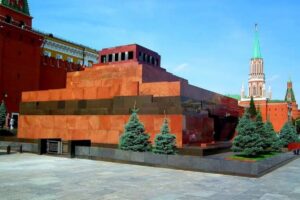 The word “mausoleum” has been used since the creation of the Wonder of the World in Halicarnassus and has spread to other cultures, surviving to this day.
The word “mausoleum” has been used since the creation of the Wonder of the World in Halicarnassus and has spread to other cultures, surviving to this day.
He managed to uncover several walls, a staircase, and eventually three corners of the foundation. With this knowledge, Newton was able to determine which plots of land he needed to purchase.
Newton carried out excavations and discovered pieces of reliefs that decorated the walls of the building, as well as parts of the stepped roof. A broken stone wheel of a chariot with a diameter of about 2m, which was made from the sculpture on the roof of the Mausoleum, was also found. Finally, he found statues of Mausolus and Artemisia that once stood atop the building.
Today, in Bodrum, the massive castle of the hospitalier knights (the knights of St. John) still stands, with the walls containing polished stone and marble blocks from the Mausoleum. Only the foundation and a small museum remain at the site of the Mausoleum.
The Hanging Gardens of Babylon
The Hanging Gardens are believed to have been built in Babylon, but why is it just a belief? Despite numerous mentions in ancient Greek and Roman texts, there is no physical evidence to confirm their existence. The gardens were said to be a square shape, around 120 meters on all sides with multiple levels, and towering at a height of 60 meters. Water was reportedly lifted to the top using a screw pump, known as the Archimedes’ screw, rotated by a windlass. However, the lack of archaeological proof has left historians and archaeologists debating whether the gardens were a historical fact or an ancient myth.
Traditionally, it is believed that the Hanging Gardens of Babylon were built either by the semi-legendary queen Semiramis or by King Nebuchadnezzar II, who ruled around 605-561 BCE. Supposedly, Nebuchadnezzar built the gardens to please his wife, Queen Amytis, who missed the mountains and greenery of her native Media.
However, there is still no concrete evidence to confirm their existence. Nevertheless, similar structures were widely used during that era.
The Hanging Gardens of Babylon is said to be the first air conditioning system in the world! It was a cascading series of gardens, featuring numerous trees, shrubs, and grapevines. It looked like a beautiful green mountain from afar, and was adorned with magnificent waterfalls.
But the gardens were much more than just an aesthetic delight, as they created a unique and comfortable microclimate. Such structures were prevalent among the Assyrians and Babylonians, and included vast systems of canals, dams, and aqueducts to deliver water and distribute it throughout all levels of the garden.
Living in homes located within these gardens was very comfortable, with the air being almost 10 degrees cooler. The heat was no longer a significant concern.
The Pyramid of Khufu
The Pyramid of Khufu, also known as the Pyramid of Cheops, is the largest and most famous of the pyramids in Egypt. It is located in Giza, a suburb of modern-day Cairo, and is part of a larger complex that includes two smaller pyramids, several temples, and many other tombs and buildings.
The Pyramid of Khufu was built over 4,500 years ago, during the Old Kingdom period of ancient Egypt. It was constructed as a grand tomb for Pharaoh Khufu, who ruled Egypt from around 2589-2566 BCE. The pyramid was originally over 146 meters high, and was the tallest man-made structure in the world until the 1300s CE.
The construction of the Pyramid of Khufu was a formidable task that required the labor of thousands of workers for many years. The pyramid is made of over 2.3 million stone blocks, each weighing several tons. The blocks were quarried from nearby areas and transported to the pyramid complex using a system of ramps and sledges.
The interior of the pyramid is a maze of passages, chambers, and corridors, designed to protect the pharaoh’s body and ensure his safe passage to the afterlife. The burial chamber inside the pyramid is made of red granite and is located at the heart of the structure. It contains the remains of the pharaoh, in addition to treasures and precious objects intended for use in the afterlife.
Despite years of extensive exploration and archaeological study, much of the Pyramid of Khufu’s history remains shrouded in mystery. There are still many unanswered questions about the construction, design, and purpose of this ancient wonder. However, its grandeur and enduring presence continue to captivate the world and inspire awe and wonder to this day.
The Pyramid of Khufu in Egypt is the only one of the “Seven Wonders of the World” that has survived to the present day. It was built 4,500 years ago.
In ancient times, the pyramid was covered with white limestone casing stones. At the top of the pyramid was a gilded capstone, known as a pyramidion. The casing stones shone and were visible from afar. However, wars and looting led to the removal of all the casing from the pyramid, leaving it bare.
Its initial height of 146.5 meters made the pyramid the tallest structure in the world until the 14th century when it was surpassed by Lincoln Cathedral.
Over the years, the outer layer of limestone has weathered away, reducing the height by almost eight meters, but the pyramid remains one of the most remarkable landmarks on the planet. According to recent estimates, it took about 14 years to transport and install the 2.3 million stone blocks used in its construction.
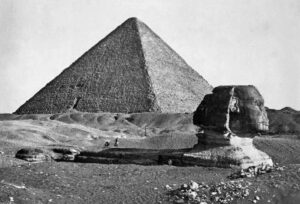 This is what the Great Sphinx looked like in 1857, prior to its excavation. The famous sculpture was buried in the sands for many years.
This is what the Great Sphinx looked like in 1857, prior to its excavation. The famous sculpture was buried in the sands for many years.
Despite the Great Pyramid of Giza, along with other minor pyramids, temples, monuments, and tombs, continuing to be highly regarded throughout Egypt’s history, the site fell into decline after the Roman occupation and annexation of the country in 30 BCE. The Romans focused their efforts on Alexandria and the abundant crops the country produced, turning Egypt into a food source for Rome.
The site remained more or less abandoned until Napoleon’s Egyptian campaign in 1798-1801, during which he brought with him a team of scholars and explorers to document ancient Egyptian culture and monuments.
The Lighthouse of Alexandria
The Lighthouse of Alexandria is the only ancient wonder of the world that served a purely functional purpose.
Alexandria was an important port city, and the lighthouse helped sailors from afar see where to head. This was a critical question, considering that the Egyptian coastline looked quite homogenous. Additionally, it enabled them to see incoming enemies. Alexandria could only be attacked from the sea, as natural defense from the desert lay on other sides.
The lighthouse was situated on the southeastern edge of the island of Pharos in the city of Alexandria, on the northern coast of Egypt. It reached a height of up to 118 meters and had a 30 x 30 meter square base.
Despite enduring five earthquakes, each causing significant damage, the lighthouse was repaired every time.
Scientists discovered in the 20th century that the location of the Lighthouse of Alexandria was highly unfavorable. Two tectonic plates – the Arabian Plate and the African Plate – converge at this location. In 1323, a powerful earthquake ultimately destroyed the lighthouse.
The ruins of the lighthouse now remain at the bottom of the Mediterranean Sea.
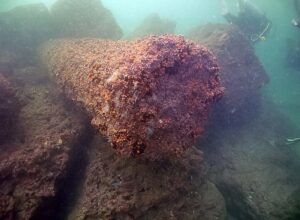 Parts of the destroyed lighthouse can still be found on the seabed of the Mediterranean.
Parts of the destroyed lighthouse can still be found on the seabed of the Mediterranean.
After the destruction of the Lighthouse of Alexandria, Sultan Qayetbay did not attempt to restore it and instead fortified the area as part of his coastal defense.
In 1968, during an archaeological expedition, the Lighthouse of Alexandria was rediscovered underwater in the Mediterranean Sea. Since then, several efforts have been undertaken to protect and preserve the submerged ruins, with some sections being removed and displayed in museums for public viewing.
Despite its unfortunate fate, the Lighthouse of Alexandria remains an important part of Egypt’s rich history and cultural heritage, as well as a symbol of the remarkable achievements of ancient engineering and architecture.
The Statue of Zeus
The Statue of Zeus is unique in that it is the only wonder of the ancient world that was located on the European mainland. It was built during the 5th century BCE.
The Olympic Games were immensely popular, held in honor of Zeus, but Athens did not have its own temple of Zeus. Therefore, it was decided to construct one along with a unique statue.
For the construction of the statue, 200 kilograms of pure gold and many precious stones were brought to the site.
The statue was almost 12 meters high, covered in gold and ivory, and depicted the god seated on an expertly crafted throne made of cedar wood, adorned with ebony, ivory, gold, and precious stones.
The statue amazed all who saw it. The “living” eyes of Zeus sparkled, and he seemed to illuminate observers with divine light. To achieve this, the sculptor created a clever pool where water mixed with olive oil, creating a unique optical effect.




























